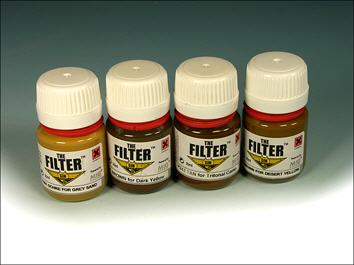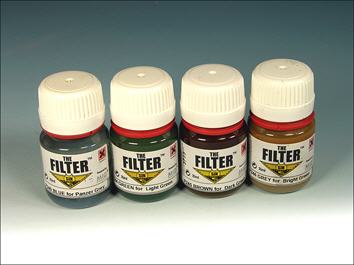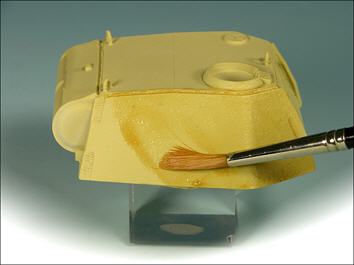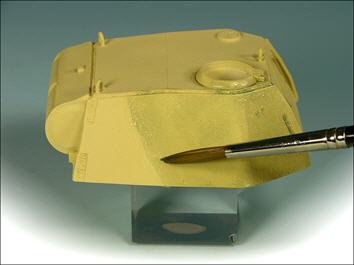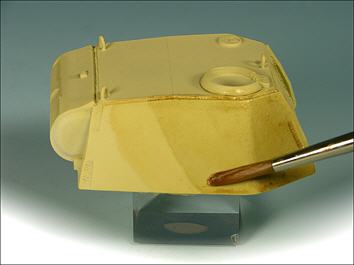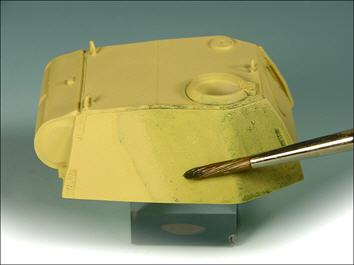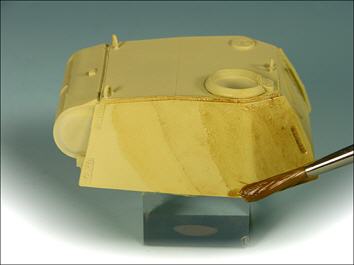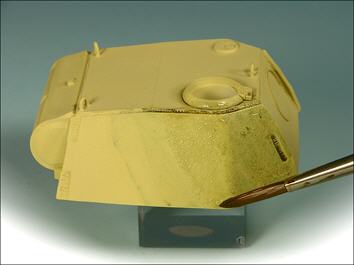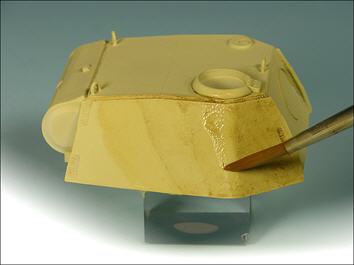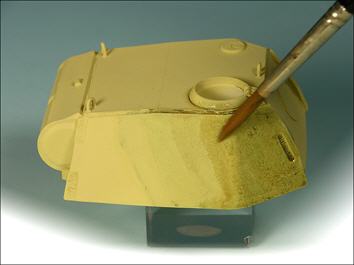Washes and Filters
The differences and ways to use them
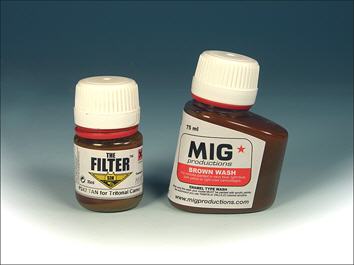
A filter or wash, they are very different, but again, similar in composition and application
Many modellers have heard of filters and washes, but very few know the differences between them and the proper application of it. Unfortunately, they are confused and modselbouwers not realize the potential of each product appart. We're both the difference between a wash and a filter state and describe their correct application.
The differences
Although it seems to be complicated, are the differences between a wash, and a filter is extremely simple but is very important here, as is described below A filter is used to bring the color nuances to the wash is often used in order to emphasize shadows. To begin with, the surface must be very different for both cases, the filter requires a total matte surface while the wash better adhesion on a satin matt or glossy surface adhesion.
If the oppevlak for both applications are different, they can then be used both?
The filter leaves a satin matte layer behind when it dries up, especially after 3 or 4 layers. This means that after the filter the surface area is designed for the application of a wash. Suitable One can always have an extra layer of satin or gloss varnish applied over the filters away to prepare for the wash. Before the Both options are possible.
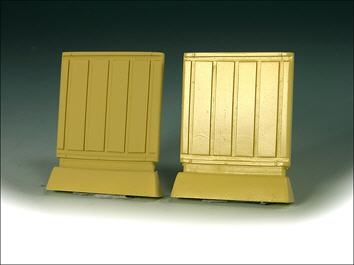
The piece left is painted in matt dark yellow and dark yellow satin court .
It 's clear to see that the piece on the left has a matte finish and is on the right side has a satin gloss finish , especially for the wash . Let us first apply a filter on the left . The filter should be applied with a damp brush just on , when you use a brush soaked you get more of a wash than a filter. Dip your brush into the filter and wipe the excess off on the edge of the pot or on a piece of paper .
Apply the filter to the gedeete which the capillary effect of the matte surface of the filter absorbs . This should be a couple of times in order to get helhaald . Uniform distribution Remove any excess that may have accumulated in absorbent paper in the corners and seams
The filter should be applied evenly over the whole operating surface. Do not let the filter around the details accumulate . The filter is a transparent color layer , it must be applied to change the color tone smooth
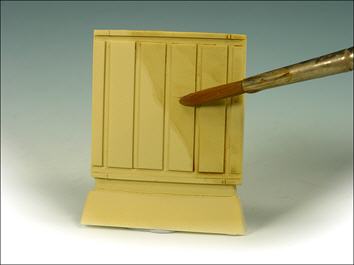
A filter should be on the surface aangbracht evenly without it accumulates in cracks and crevices.
A wash should be applied around the details, etc. plate seams to accentuate more depth and to create volume. These correctly The wash is generally darker and more intense in color so that care must be taken. Exuberance for You can leave the wash also run as shown. In the example below in the grooves and seams
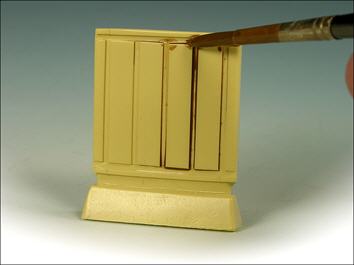
The wash is more opaque and accumulates in the grooves and around the details.
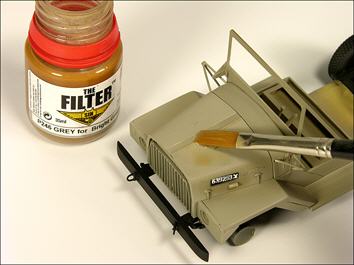
The filter is one of the techniques most commonly used , it is ready and easy to apply .
As previously mentioned, the filter is a technique which consists of the application of multiple layers of transparent thin uniformly applied to a surface in order to create more. Color shade , depth and color enrichment Ht with Aibrush aabrengen lighter color to the color onderligende is an option , but these can sometimes be opaque for the right effect . Filters give you more control to apply and easier
Filters can also camouflages complex can harmonize , they are also good to create . Damaged vehicles or any other securities of mud, dust or rust Filters are especially suitable for very large vehicles with high surface area and few details like for example the Elefant , Jagdtijger , Abramhams , Leopards
The various filters can be combined into one , the desired result was achieved. On the same model For example , if you think green with green stuff too gray or matte example, one blue , tan or yellow filters , etc. to give . More green look
One can also gruiken a gray filter in order to obtain , in order to make . The color diversity to more homogeneous the opposite effect Filters are very easy to apply , a product without much experience the results are very good .
It is also possible to provide through the use of a different color filter on , for example, hatches or hatch edges, or other objects to pass. Certain details a different appearance One can thus greater realism and greater diversity in colors krijgen.Het is very important when applying multiple filters it to dry completely . Least one hour between the different filters
MIG offers a wide range of color filters for large contemporary or historic vehicles , such as filters to decorate . Allied or German vehicles Although these colors are recommendations , the modeler can combine them together to get a different effect. Below are two examples of the application of filters applied to the same base color where the differences are clearly visible :
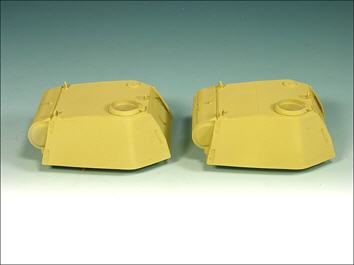
Above are two panther domes painted the same color to see in the application of different filters , the differences
The two domes is a tipical sand color applied with Vallejo paints . As seen in the pictures is the surface mat. One of the domes traditional filers are used as brown and ocher , on the other dome are more different filters applied as blue , green and dark bruin.Zie results after four consecutive filters:
Note that the filter has changed slightly with each additional filter layer , the color of the base color . The color is darker slowly with each layer . A filter can not make a color brighter , so it is better to use . Lichtee basiskkleur one of the original vehicle The filter is applied with a brush in order to bring it with a soft round brush. An homogeneous layer of It is important that the filter is applied with a damp brush just get a different kind of wash . The example above shows the difference to the original base paint , and the areas in which the filters are applied .
Note that the filter has changed slightly with each additional filter layer, the color of the base color. The color is darker slowly with each layer. A filter can not make a color brighter, so it is better to use. Lichtee basiskkleur one of the original vehicle The filter is applied with a brush in order to bring it with a soft round brush. An homogeneous layer of It is important that the filter is applied with a damp brush just get a different kind of wash. The example above shows the difference to the original base paint, and the areas in which the filters are applied.
It marks the difference between the area with and without filter applied.
Here we can observe a typical example of abundance of filter. If too much is applied, and it will accumulate in the lower part. Although it is a mistake, is easy to solve. The mandate over with a dry cloth or absorbent paper to remove.
It is necessary to take in order not to compromise by using a minimum. At the same time too much to filter precaution
washes
The wash can be used. Different things The usual application of a wash is to emphasize the details and to create volume. Also adds an effect of dirt or grease that opgrehoopt dry in parts of engines can be very interesting.
The wash is more intense than the filter and should be used more carefully.
The model is divided into several parts to make. The wash each section Never cover the entire model with a wash in 1 time. It is best to first practice to get to spend. Around the details and shutters etc. The technique mastered with a wash on an old model
The wash just run into the seams and details about the surplus can be removed by a brush with clean turpentine. Do not do this until the wash is not dry
It uses the wash to stress, and to provide depth to make. Effects of, for example, fuel leak details
The wash should be applied to achieve. The maximum effect on a satin surface See the difference above.
Source: Mig Productions, (c) 2002-07 MIG PRODUCTIONS FACTORY SL
